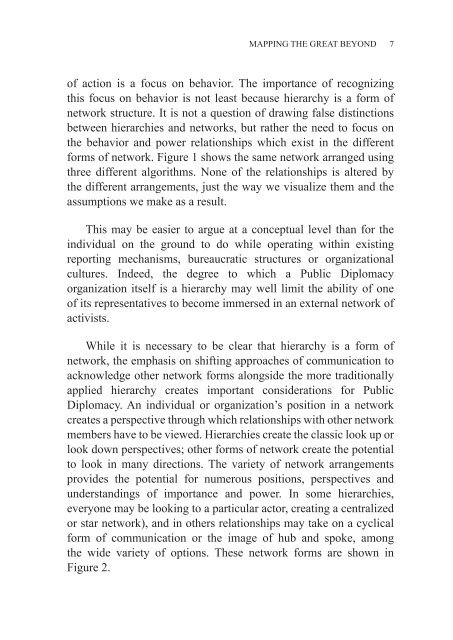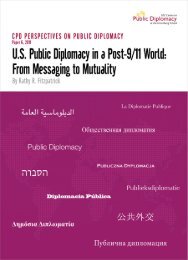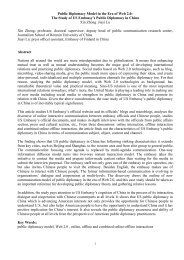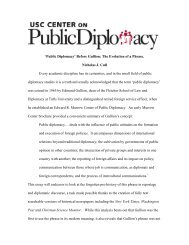Mapping the Great Beyond: Identifying Meaningful Networks in
Mapping the Great Beyond: Identifying Meaningful Networks in
Mapping the Great Beyond: Identifying Meaningful Networks in
You also want an ePaper? Increase the reach of your titles
YUMPU automatically turns print PDFs into web optimized ePapers that Google loves.
MAPPING THE GREAT BEYOND 7<br />
of action is a focus on behavior. The importance of recogniz<strong>in</strong>g<br />
this focus on behavior is not least because hierarchy is a form of<br />
network structure. It is not a question of draw<strong>in</strong>g false dist<strong>in</strong>ctions<br />
between hierarchies and networks, but ra<strong>the</strong>r <strong>the</strong> need to focus on<br />
<strong>the</strong> behavior and power relationships which exist <strong>in</strong> <strong>the</strong> different<br />
forms of network. Figure 1 shows <strong>the</strong> same network arranged us<strong>in</strong>g<br />
three different algorithms. None of <strong>the</strong> relationships is altered by<br />
<strong>the</strong> different arrangements, just <strong>the</strong> way we visualize <strong>the</strong>m and <strong>the</strong><br />
assumptions we make as a result.<br />
This may be easier to argue at a conceptual level than for <strong>the</strong><br />
<strong>in</strong>dividual on <strong>the</strong> ground to do while operat<strong>in</strong>g with<strong>in</strong> exist<strong>in</strong>g<br />
report<strong>in</strong>g mechanisms, bureaucratic structures or organizational<br />
cultures. Indeed, <strong>the</strong> degree to which a Public Diplomacy<br />
organization itself is a hierarchy may well limit <strong>the</strong> ability of one<br />
of its representatives to become immersed <strong>in</strong> an external network of<br />
activists.<br />
While it is necessary to be clear that hierarchy is a form of<br />
network, <strong>the</strong> emphasis on shift<strong>in</strong>g approaches of communication to<br />
acknowledge o<strong>the</strong>r network forms alongside <strong>the</strong> more traditionally<br />
applied hierarchy creates important considerations for Public<br />
Diplomacy. An <strong>in</strong>dividual or organization’s position <strong>in</strong> a network<br />
creates a perspective through which relationships with o<strong>the</strong>r network<br />
members have to be viewed. Hierarchies create <strong>the</strong> classic look up or<br />
look down perspectives; o<strong>the</strong>r forms of network create <strong>the</strong> potential<br />
to look <strong>in</strong> many directions. The variety of network arrangements<br />
provides <strong>the</strong> potential for numerous positions, perspectives and<br />
understand<strong>in</strong>gs of importance and power. In some hierarchies,<br />
everyone may be look<strong>in</strong>g to a particular actor, creat<strong>in</strong>g a centralized<br />
or star network), and <strong>in</strong> o<strong>the</strong>rs relationships may take on a cyclical<br />
form of communication or <strong>the</strong> image of hub and spoke, among<br />
<strong>the</strong> wide variety of options. These network forms are shown <strong>in</strong><br />
Figure 2.











